- Details
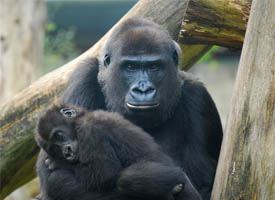 Zachary, a baby western lowland gorilla, was unveiled this week at Brookfield Zoo in suburban Chicago. The baby gorilla, born earlier this week, will spend the next four to six months in the arms of his mother, 11 year-old Kamba. After that, he will spend most of his days on Kamba’s back until learning to move on his own.
Zachary, a baby western lowland gorilla, was unveiled this week at Brookfield Zoo in suburban Chicago. The baby gorilla, born earlier this week, will spend the next four to six months in the arms of his mother, 11 year-old Kamba. After that, he will spend most of his days on Kamba’s back until learning to move on his own.
Zachary joins the more than 300 western lowland gorillas living in zoos across North America. Native to West Africa, the gorilla remains an endangered species due to hunting, habitat destruction and disease.
Learn more:
Read more about the birth of Zachary
Raw: Illinois Zoo Announces New Baby Gorilla (Associated Press on YouTube)
- Details
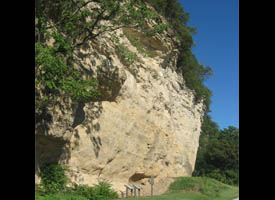 The Modoc Rock Shelter, located near the Missouri border in Southern Illinois, is a cut-out section of cliff overlooking the Mississippi River valley. The cliff was formed by ice age floods that carved through the land thousands of years ago.
The Modoc Rock Shelter, located near the Missouri border in Southern Illinois, is a cut-out section of cliff overlooking the Mississippi River valley. The cliff was formed by ice age floods that carved through the land thousands of years ago.
Archaeological discoveries by Irwin Peithmann in the 1950s found artifacts in the shelter that proved groups of people had been there as far back as 9,000 years ago. From Peithmann’s discoveries, it has been concluded that Native American hunters used the shelter as a safe area away from the elements. His excavations also have concluded different groups used the site as a long-term base camp around 6,000 years ago, and small hunting parties inhabited the area around 4,000 years ago. Hammer stones, bone awls and projectile points are just a few of the many discoveries found at the site.
It was declared a National Historic Landmark in 1961.
Learn more:
Visiting the Modoc Rock Shelter? Learn more about the site and plan your trip here
- Details
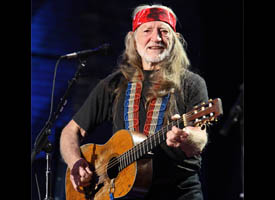 The first Farm Aid concert was held on this day in 1985 at Memorial Stadium in Champaign. The event, which attracted more than 80,000 people, was held to raise money for family farmers throughout the country who were struggling with drastically falling land prices and the rise of large corporate farms.
The first Farm Aid concert was held on this day in 1985 at Memorial Stadium in Champaign. The event, which attracted more than 80,000 people, was held to raise money for family farmers throughout the country who were struggling with drastically falling land prices and the rise of large corporate farms.
More than 100 musical acts performed at the event, including The Beach Boys, Bon Jovi, B.B. King, Bonnie Raitt and Willie Nelson. Nelson, along with John Mellencamp and Neil Young, were key organizers of the first Farm Aid. More than $9 million was raised during the event.
Since 1985, Farm Aid concerts have been held across the country. The New World Music Theater (now Hollywood Casino Amphitheatre) in Tinley Park hosted Farm Aid ’97 and ’98 as well as the 20th anniversary concert in 2005.
Over the weekend, the 30th anniversary concert was held at FirstMerit Bank Pavilion in Chicago, drawing nearly 30,000 concertgoers and hosting Dave Matthews, Imagine Dragons, Willie Nelson and Chicagoan Mavis Staples.
Learn more:
Read more about Farm Aid and the mission behind the concerts
- Details
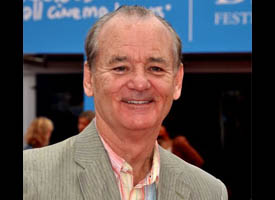 Famous actor and comedian Bill Murray was born on this day in 1950 to Lucille and Edward Joseph Murray II. Murray was raised in Chicago’s northern suburbs and began his stand-up career at the infamous Second City comedy club after an invitation to attend by his older brother, Brian Murray.
Famous actor and comedian Bill Murray was born on this day in 1950 to Lucille and Edward Joseph Murray II. Murray was raised in Chicago’s northern suburbs and began his stand-up career at the infamous Second City comedy club after an invitation to attend by his older brother, Brian Murray.
Soon after he joined Second City, Murray was recruited to join “Saturday Night Live” by another famous Illinois comedian, John Belushi. Murray joined “Saturday Night Live” in its second year, making him one of the show’s earliest stars. He worked as a cast member for three seasons from 1977 until 1980.
Murray gained national attention in the 1980s by starring in multiple blockbuster hits, including “Ghostbusters” in 1984, earning him a nomination for the Golden Globe Award for Best Actor in a Comedian or Musical. Murray won an Emmy Award last night for his role in the HBO mini-series “Olive Kitteridge.”
Learn more:
Read more about Bill Murray’s career on IMDb
Entertainment Weekly: Bill Murray wins Emmy for supporting actor in a limited series or movie
- Details
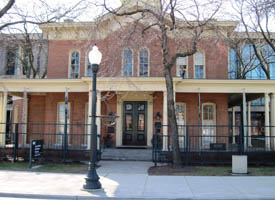 Chicago’s Hull-House opened its doors on September 18, 1889, on Chicago’s Near West Side. The home was Chicago’s first settlement house, which served newly arrived immigrants through a variety of educational, social and health support services. At the time, settlement houses were popping up all over industrial cities with large immigrant populations, mainly in the Northeast and Midwest.
Chicago’s Hull-House opened its doors on September 18, 1889, on Chicago’s Near West Side. The home was Chicago’s first settlement house, which served newly arrived immigrants through a variety of educational, social and health support services. At the time, settlement houses were popping up all over industrial cities with large immigrant populations, mainly in the Northeast and Midwest.
Jane Addams and Ellen Gates Starr, both from upper-middle-class backgrounds, opened Hull-House after the mansion’s owner, Charles Hull, donated his property to the women. By the early 1900s, Hull-House had expanded to include 13 buildings on two city blocks. Included in the complex were a gymnasium, theater, art gallery, boys’ club, nursery, kindergarten classes and dining and living quarters for staff members.
The work of Jane Addams and Ellen Gates Starr helped countless new citizens adjust to American culture and helped implement new laws protecting women and children and safeguards for workers.
Learn more:
Read more about the history of the Hull-House in Chicago
Visiting Hull-House? Read more about the Jane Addams Hull-House Museum
More Articles …
- Did You Know? Illinois is home to America’s first planetarium
- Did You Know? Famous baritone saxophonist Hamiet Bluiett is from Illinois
- Did You Know? Jazz legend Miles Davis grew up in Illinois
- Did You Know? The first televised political debate was filmed in Illinois
- Did You Know? Singer and actress Jennifer Hudson is from Illinois





